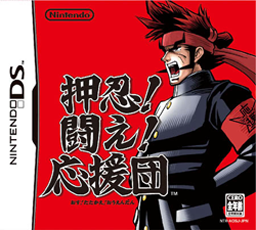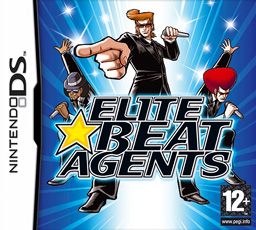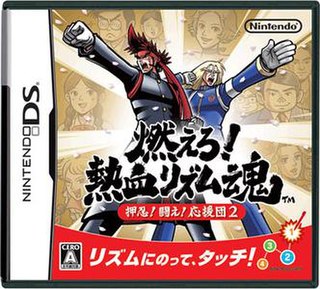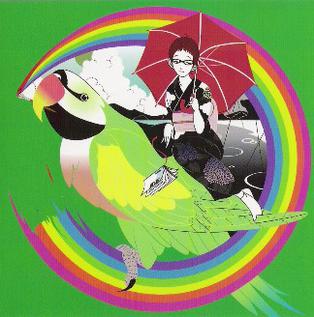
.sh is the Internet country code top-level domain (ccTLD) for the British Overseas Territory of Saint Helena, Ascension and Tristan da Cunha, although it is primarily used in Saint Helena. Registrations of internationalized domain names are also accepted.

An ōendan (応援団), literally "cheering squad" or "cheering section", is a Japanese sports rallying team similar in purpose to a cheerleading squad in the United States, but relies more on making a lot of noise with taiko drums, blowing horns and other items, waving flags and banners, and yelling through plastic megaphones in support of their sports team than on acrobatic moves. In addition to cheering for their own teams, ōendan have been known to lead fans in cheers which tease and taunt the other team and its fans. This is usually done in the spirit of good competition, but occasional fights have broken out if the taunting gets too heated. Smaller ōendan are sometimes called ōenbu.

Osu! Tatakae! Ouendan, or Ouendan, is a rhythm video game developed by iNiS and published by Nintendo for the Nintendo DS handheld game console in 2005, for release only in Japan. Ouendan stars a cheer squad rhythmically cheering for various troubled people, presented in-game in the style of a manga comic. In each stage, players use the DS touchscreen to tap specifically marked spots that appear in rhythm to various Japanese pop songs, scoring points for accurate timing and avoiding a poor performance which can cause the stage to end prematurely. Though never released in Western markets, it was a popular import to these regions, leading to the development of the Westernized spiritual sequel Elite Beat Agents, as well as a direct Japanese sequel Moero! Nekketsu Rhythm Damashii Osu! Tatakae! Ouendan 2.

Elite Beat Agents is a rhythm video game developed by iNiS and published by Nintendo for the Nintendo DS. It was released in North America, Europe and South Korea. As the second of three rhythm games developed by iNiS specifically for the DS, it is the spiritual sequel and international counterpart to Osu! Tatakae! Ouendan, a Japanese rhythm game released in 2005, sharing many common elements with it.

Disney Sports Skateboarding is a pair of 2002 sports video games released by Konami, one for the GameCube, and the other for the Game Boy Advance.

Taiko no Tatsujin is a video game series created by Namco. In the games, players simulate playing a taiko drum in time with music. The series has released games for the arcade and for console and mobile platforms including PlayStation 2, Advanced Pico Beena, PlayStation Portable, Nintendo DS, Wii, Nintendo 3DS, Wii U, PlayStation Vita, PlayStation 4, Nintendo Switch, Xbox One, Xbox Series X/S, Microsoft Windows, iOS, Android and Japanese feature phones.

"Glamorous Sky" is Mika Nakashima's 16th single overall, her 1st under the name Nana starring Mika Nakashima, and the second most successful single in her career after "Stars". It is her first rock song and it was used as one of the image songs for the film Nana. Hyde of L'Arc-en-Ciel composed "Glamorous Sky". The second and third B-sides, "Blood" and "Isolation" were used as CM songs for Kate cosmetics. Mika Nakashima graces the cover of the single as Nana Osaki.
Mihimaru GT were an urban and pop music group signed to Universal Music Japan and managed by Tearbridge Productions, a subsidiary of Stardust Promotion and Avex.
The Sims Stories is a series of video games from The Sims series released between 2007 and 2008, based on a modified version of The Sims 2 game engine. The modified game engine is optimized for play on systems with weaker specifications, such as laptops. As such, its system requirements are lower than that of The Sims 2, but it can still be played on desktops. The series was aimed to cater to three groups of players: players who wish to play The Sims 2 on their laptops ; players who wish to engage in other activities such as instant messaging while playing the game; and players who are new to the franchise. Titles in this series are categorized as "laptop-friendly" since they do not require a dedicated graphic card.

"Ready Steady Go" is the twenty-third single by L'Arc-en-Ciel, released on February 4, 2004; it reached number 1 on the Oricon chart. The four alternate versions on the single omit each titular band member's contributions; for instance, the "Hydeless Version" features none of hyde's vocals, while the "Yukihiroless Version" has no percussion whatsoever.

Moero! Nekketsu Rhythm Damashii: Osu! Tatakae! Ouendan 2 is a rhythm video game developed by iNiS and published by Nintendo for the Nintendo DS handheld video game console. It is the third of three rhythm games developed by iNiS for the DS, and is the sequel to Osu! Tatakae! Ouendan while incorporating many of the improvements in gameplay made in its international counterpart, Elite Beat Agents. The game has 4-player wireless play, supports the Nintendo DS Rumble Pak accessory, and was released in Japan on May 17, 2007.

"RIRURA RIRUHA [リルラ リルハ]" is the third single by Japanese pop singer Kaela Kimura, and the first from her album Circle. Released March 30, 2005, it peaked at number three on the Japan Oricon singles chart, Kimura's highest charting single to date. By the end of 2005, Real Life Real Heart had sold 117,299 copies.
Japanese rock duo B'z has released 22 studio albums, 12 compilation albums, nine extended plays (EP), 62 singles, and 20 live albums. With more than 86 million sales in Japan, the duo is the best-selling artist in Japan and with 100 million sales one of the best-selling music artists of all time.

"Atsuki Kodou no Hate" (熱き鼓動の果て) is the thirty-third single by B'z, released on June 5, 2002. This song is one of B'z many number-one singles in Oricon charts. The song was featured in the arcade drumming game Taiko no Tatsujin and also on the Nintendo DS rhythm game Osu! Tatakae! Ouendan.

Jubeat, stylized as jubeat, is a series of arcade music video games developed by Konami, and is a part of Konami's Bemani line of music video games. The series uses an arrangement of 16 transparent buttons in a 4x4 grid for gameplay, and each of the 16 buttons overlays a screen.

"Linda Linda" (リンダリンダ) is a single by the Japanese punk rock band The Blue Hearts that was released on May 1, 1987. Lyrics and music were written by Hiroto Kōmoto, the band's lead vocalist, and was arranged by The Blue Hearts. The track reached No. 38 on the Oricon charts during its release year.

"Loop & Loop" is a song by the Japanese rock band Asian Kung-Fu Generation. It was the second single released from their second full-length studio album, Sol-fa, on May 19, 2004.
Ken Hirai is a Japanese R&B and pop singer. Since his debut, Hirai has worked as a model, actor, composer, lyricist, singer, and brand ambassador.

Beat Saber is a virtual reality rhythm game developed by Slovaks Ján Ilavský, Vladimír Hrinčár, and Peter Hrinčár. The game was published by Czech game developer Beat Games. It takes place in many different surrealistic neon environments and features the player slicing blocks representing musical beats with a pair of brightly-colored sabers. Following an early access release in May 2018, the game was officially released for PlayStation 4 and Windows on May 21, 2019, and for the Meta Quest in standalone mode.
The Osu! Tatakae! Ouendan series was developed by iNiS Corporation exclusively for the Nintendo DS system and published by Nintendo. It consists of the Japan-exclusive Osu! Tatakae! Ouendan duology and its international counterpart, Elite Beat Agents, which contains the same gameplay but had its characters and themes adapted to fit a Western audience.

















